CellBazaar, often called the "Mobile Craigslist of Bangladesh", has provided a martketplace to buy and sell goods and service to Bangladeshis for three and a half years now. We reported on the organization previously in April 2008. Since then, the service has grown and has now user base of just under 4 million. Cell Bazaar processes 1000 posts/day, and founder Kamal Qadir was chosen by the World Economic Forum as a Young Global Leader in 2009.
I caught up with Kamal recently and talked to him about two things that I had wondered about CellBazaar that had not been emphasized in the coverage they have received.
Charging Standard Rates
The first question I had was about how much users paid for messages. Most services like CellBazaar that work over SMS operate with premium SMS-pricing. Premium SMS refers to SMS for which users pay a premium over standard messaging costs, with the revenue shared between service provider and telecommunications operator. Some development projects pay the premium themselves rather than making users pay, but in either case, a premium is charged by telecommunications operators.
Kamal noted that SMSs sent to CellBazaar cost a user the same price as a standard SMS. GrameenPhone, CellBazaar's partner, shares a percentage of the messaging revenue with CellBazaar. CellBazaar also gets revenue from users that access its WAP and voice services similarly--another source of revenue that m-services do not usually access. (The rough revenue breakdown, which Kamal told me parallels the volume breakdown, is roughly WAP 50%, SMS 25%, Voice 20%).
Of course, this revenue-sharing model would not be possible without a strong partnership with GrameenPhone, CellBazaar's only core partner. In a May 2009 paper, Zainudeen et al. point to affordability and the strong partnership between CellBazaar and GrameenPhone as one of its critical success factors. (Katrin Verclas, in a MobileActive.org whitepaper, also points to an ecosystem of partners that includes mobile network operators as a critical success factor for scaling m-services).
Why No USSD?
I also asked Kamal why CellBazaar does not use USSD -- CellBazaar's sample SMS interactions show a series of messages that seem to be the perfect fit for a session-based USSD interaction. Kamal pointed to USSD's technology and aesthetic limitations.
First, USSD 2.0 gateways were simply not available on Grameen Phone when CellBazaar started. But even after they were available, Kamal said that it was not possible to write dynamic menus on the USSD platform available with Grameen Phone. CellBazaar's menus change depending on what users are selling and buying--no use telling a user to click on a 'refrigerator' category if there are no 'refrigerators' being sold at the moment--and Kamal said that this was not possible to do with USSD technology available at Grameen.
Moreover, USSD simply wasn't pretty enough for a market-based service, Kamal said. Kamal thought USSD should be fine for uses working with mobile money, and other basic services, but that users want a better experience when shopping. He also mentioned that the high availability of WAP phones means that USSD is easy to be supplanted with newer technologies that are easier to use.
(Picture: A Nokia cell-phone being sold on CellBazaar's marketplace).
| CellBazaar, Bangladesh's Burgeoning Mobile Marketplace data sheet 17334 Views | |
|---|---|
| Countries: | Bangladesh |


Post new comment